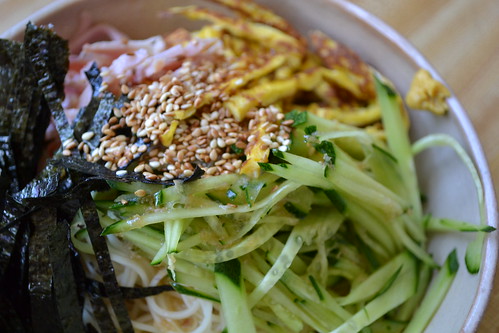 PREFACE
Summer Slurp Series, Pt. 1: Nikumiso Udon
The one (and only) thing that I miss about the disgustingly humid temperatures in Tokyo is the arrival of cold noodle dishes on menus everywhere. During the hot months of June through September, I would convince myself that I deserved a daily reward of a big bowl of cold noodles for surviving each hot day. There are many hiyashi-men (cold noodle) dishes, but the most common ones are zaru soba, somen, nikumiso udon, and hiyashi chuka.
The second installment in Japanify's Summer Slurp Series introduces hiyashi chuka.
PREFACE
Summer Slurp Series, Pt. 1: Nikumiso Udon
The one (and only) thing that I miss about the disgustingly humid temperatures in Tokyo is the arrival of cold noodle dishes on menus everywhere. During the hot months of June through September, I would convince myself that I deserved a daily reward of a big bowl of cold noodles for surviving each hot day. There are many hiyashi-men (cold noodle) dishes, but the most common ones are zaru soba, somen, nikumiso udon, and hiyashi chuka.
The second installment in Japanify's Summer Slurp Series introduces hiyashi chuka.
+++
Hiyashi chuka (cold ramen) is an attractive looking dish. Cold ramen noodles are piled onto a plate and topped with strips of cucumber, ham, egg and seaweed. On a hot day, the cold noodles coated with a sweet and sour sauce accompanied by crunchy cucumbers, umamiful ham and a dab of hot mustard, looks like the best option amongst hot noodle soup or fried rice.
As a child, my mom would prepare the instant stuff by
Chukazanmai. When I think back on it though, the only instant part about instant
hiyashi chuka is the sauce that is draped over the noodles. My mom still had to fry the egg and cut all the ingredients. It was definitely not like those
Tasty Bites pouch packs.
As long as you have all your ingredients lined up,
hiyashi chuka is a no-brainer. The only thing you really need to cook are the noodles and an egg. The rest is just about plating your ingredients.
Hiyashi Chuka (Cold Ramen)
Serves two people
INGREDIENTS
2 servings of ramen noodles (preferably the fresh noodles in the refrigerated section)
1 Japanese julienned cucumber
1/4 lb. of ham, cut into strips
1-2 eggs
1 large sheet of
nori (seaweed), cut into strips
1 tbsp roasted sesame seeds
1 tsp
karashi (Japanese mustard)
1 tbsp grated ginger
Sauce
1/3 cup dashi
3 tbsp vinegar
2 tbsp soy sauce
2 tbsp sugar
1 tsp sesame oil
2 cloves grated garlic
METHOD
1. Add water in a big pot for boiling noodles. Set stove on high.
2. While the water is boiling, julienne cucumbers and ham.
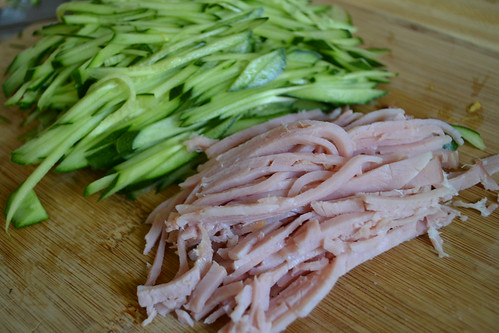
3. Grate garlic and ginger. Cut the
nori into strips. Roast sesame. Mix
karashi (if you are
making it out of a can). Set all these ingredients aside.

4. Combine ingredients for the sauce (including the garlic you just grated). Make sure the sugar in the sauce has dissolved.
5. Keep your eye on the stove: once the water boils, add the noodles (see package for cooking time).
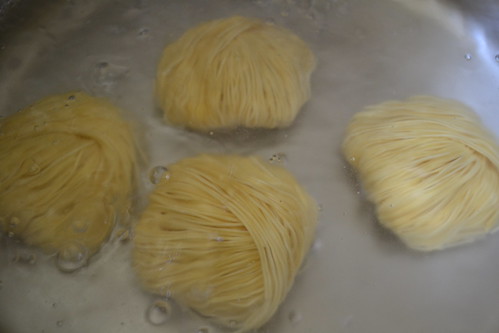
6. Fry the egg into a thin omelet.
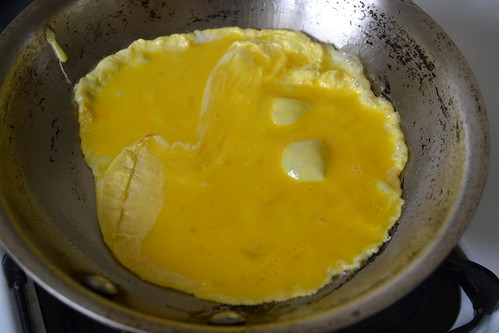

7. When the egg cools, cut into strips.
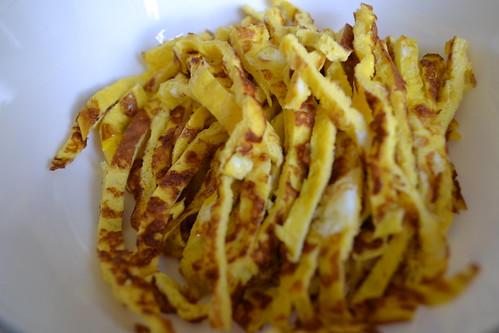
8. When the noodles are cooked, strain them with cold water from the faucet running through the noodles. Prepare a cold ice bath for the noodles and dunk the strainer full of noodles in the ice bath. Leave for a few minutes until the noodles get really cold.
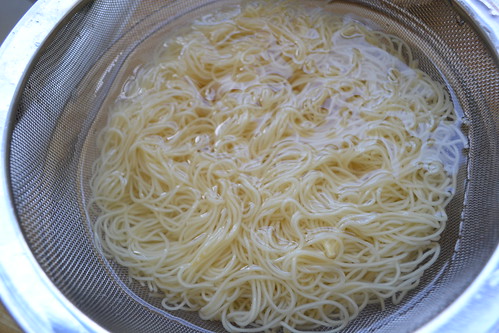
9. Strain the noodles well after removing from the ice bath. Plate noodles with your hands. Grab a handful and place a pile in the center of the plate. Lay the cucumber, ham, egg strips and
nori over the noodles.
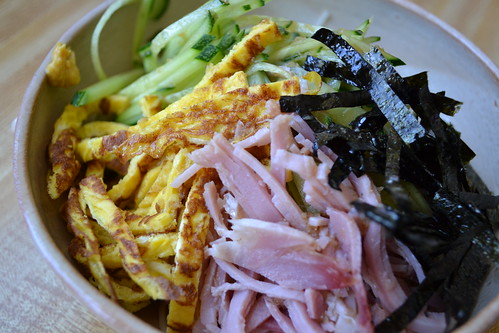
10. Sprinkle some sesame seeds over the the strips. Smear
karashi on the rim of the plate and plop some ginger on the plate.

11. Drape half the portion of sauce over each plate.
Mix.
 Hiyashi chuka
Hiyashi chuka involves a long list of ingredients but requires very little cooking. You can even prepare all the toppings in advance, then just boil the noodles when you are ready to eat.
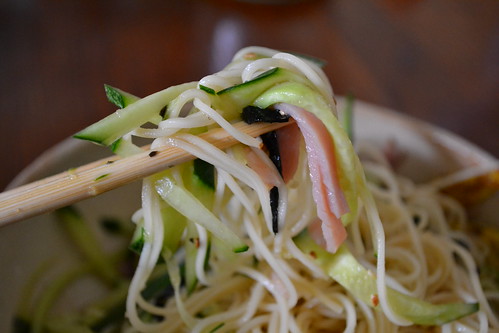
The variety of ingredients in
hiyashi chuka synergize for a party of flavors and textures that are heavenly on a hot day.
*Every Thursday, Japanify aims to make Japanese cooking at home easy, accessible and affordable. For questions, please email Yoko directly at yoko@umamimart.com or simply comment below!
 PREFACE
Summer Slurp Series, Pt. 1: Nikumiso Udon
The one (and only) thing that I miss about the disgustingly humid temperatures in Tokyo is the arrival of cold noodle dishes on menus everywhere. During the hot months of June through September, I would convince myself that I deserved a daily reward of a big bowl of cold noodles for surviving each hot day. There are many hiyashi-men (cold noodle) dishes, but the most common ones are zaru soba, somen, nikumiso udon, and hiyashi chuka.
The second installment in Japanify's Summer Slurp Series introduces hiyashi chuka.
+++
Hiyashi chuka (cold ramen) is an attractive looking dish. Cold ramen noodles are piled onto a plate and topped with strips of cucumber, ham, egg and seaweed. On a hot day, the cold noodles coated with a sweet and sour sauce accompanied by crunchy cucumbers, umamiful ham and a dab of hot mustard, looks like the best option amongst hot noodle soup or fried rice.
As a child, my mom would prepare the instant stuff by Chukazanmai. When I think back on it though, the only instant part about instant hiyashi chuka is the sauce that is draped over the noodles. My mom still had to fry the egg and cut all the ingredients. It was definitely not like those Tasty Bites pouch packs.
As long as you have all your ingredients lined up, hiyashi chuka is a no-brainer. The only thing you really need to cook are the noodles and an egg. The rest is just about plating your ingredients.
Hiyashi Chuka (Cold Ramen)
Serves two people
INGREDIENTS
2 servings of ramen noodles (preferably the fresh noodles in the refrigerated section)
1 Japanese julienned cucumber
1/4 lb. of ham, cut into strips
1-2 eggs
1 large sheet of nori (seaweed), cut into strips
1 tbsp roasted sesame seeds
1 tsp karashi (Japanese mustard)
1 tbsp grated ginger
Sauce
1/3 cup dashi
3 tbsp vinegar
2 tbsp soy sauce
2 tbsp sugar
1 tsp sesame oil
2 cloves grated garlic
METHOD
1. Add water in a big pot for boiling noodles. Set stove on high.
2. While the water is boiling, julienne cucumbers and ham.
PREFACE
Summer Slurp Series, Pt. 1: Nikumiso Udon
The one (and only) thing that I miss about the disgustingly humid temperatures in Tokyo is the arrival of cold noodle dishes on menus everywhere. During the hot months of June through September, I would convince myself that I deserved a daily reward of a big bowl of cold noodles for surviving each hot day. There are many hiyashi-men (cold noodle) dishes, but the most common ones are zaru soba, somen, nikumiso udon, and hiyashi chuka.
The second installment in Japanify's Summer Slurp Series introduces hiyashi chuka.
+++
Hiyashi chuka (cold ramen) is an attractive looking dish. Cold ramen noodles are piled onto a plate and topped with strips of cucumber, ham, egg and seaweed. On a hot day, the cold noodles coated with a sweet and sour sauce accompanied by crunchy cucumbers, umamiful ham and a dab of hot mustard, looks like the best option amongst hot noodle soup or fried rice.
As a child, my mom would prepare the instant stuff by Chukazanmai. When I think back on it though, the only instant part about instant hiyashi chuka is the sauce that is draped over the noodles. My mom still had to fry the egg and cut all the ingredients. It was definitely not like those Tasty Bites pouch packs.
As long as you have all your ingredients lined up, hiyashi chuka is a no-brainer. The only thing you really need to cook are the noodles and an egg. The rest is just about plating your ingredients.
Hiyashi Chuka (Cold Ramen)
Serves two people
INGREDIENTS
2 servings of ramen noodles (preferably the fresh noodles in the refrigerated section)
1 Japanese julienned cucumber
1/4 lb. of ham, cut into strips
1-2 eggs
1 large sheet of nori (seaweed), cut into strips
1 tbsp roasted sesame seeds
1 tsp karashi (Japanese mustard)
1 tbsp grated ginger
Sauce
1/3 cup dashi
3 tbsp vinegar
2 tbsp soy sauce
2 tbsp sugar
1 tsp sesame oil
2 cloves grated garlic
METHOD
1. Add water in a big pot for boiling noodles. Set stove on high.
2. While the water is boiling, julienne cucumbers and ham.
 3. Grate garlic and ginger. Cut the nori into strips. Roast sesame. Mix karashi (if you are making it out of a can). Set all these ingredients aside.
3. Grate garlic and ginger. Cut the nori into strips. Roast sesame. Mix karashi (if you are making it out of a can). Set all these ingredients aside.
 4. Combine ingredients for the sauce (including the garlic you just grated). Make sure the sugar in the sauce has dissolved.
5. Keep your eye on the stove: once the water boils, add the noodles (see package for cooking time).
4. Combine ingredients for the sauce (including the garlic you just grated). Make sure the sugar in the sauce has dissolved.
5. Keep your eye on the stove: once the water boils, add the noodles (see package for cooking time).
 6. Fry the egg into a thin omelet.
6. Fry the egg into a thin omelet.

 7. When the egg cools, cut into strips.
7. When the egg cools, cut into strips.
 8. When the noodles are cooked, strain them with cold water from the faucet running through the noodles. Prepare a cold ice bath for the noodles and dunk the strainer full of noodles in the ice bath. Leave for a few minutes until the noodles get really cold.
8. When the noodles are cooked, strain them with cold water from the faucet running through the noodles. Prepare a cold ice bath for the noodles and dunk the strainer full of noodles in the ice bath. Leave for a few minutes until the noodles get really cold.
 9. Strain the noodles well after removing from the ice bath. Plate noodles with your hands. Grab a handful and place a pile in the center of the plate. Lay the cucumber, ham, egg strips and nori over the noodles.
9. Strain the noodles well after removing from the ice bath. Plate noodles with your hands. Grab a handful and place a pile in the center of the plate. Lay the cucumber, ham, egg strips and nori over the noodles.
 10. Sprinkle some sesame seeds over the the strips. Smear karashi on the rim of the plate and plop some ginger on the plate.
10. Sprinkle some sesame seeds over the the strips. Smear karashi on the rim of the plate and plop some ginger on the plate.
 11. Drape half the portion of sauce over each plate. Mix.
11. Drape half the portion of sauce over each plate. Mix.
 Hiyashi chuka involves a long list of ingredients but requires very little cooking. You can even prepare all the toppings in advance, then just boil the noodles when you are ready to eat.
Hiyashi chuka involves a long list of ingredients but requires very little cooking. You can even prepare all the toppings in advance, then just boil the noodles when you are ready to eat.
 The variety of ingredients in hiyashi chuka synergize for a party of flavors and textures that are heavenly on a hot day.
*Every Thursday, Japanify aims to make Japanese cooking at home easy, accessible and affordable. For questions, please email Yoko directly at yoko@umamimart.com or simply comment below!
The variety of ingredients in hiyashi chuka synergize for a party of flavors and textures that are heavenly on a hot day.
*Every Thursday, Japanify aims to make Japanese cooking at home easy, accessible and affordable. For questions, please email Yoko directly at yoko@umamimart.com or simply comment below!




Comments (7)
Again, I praise you using all clad for making tamago yaki. That’s just crazy… I recently found dried ramen noodles next to udon/soba to be pretty awesome to use for this. Adding taberu-rayu (chili oil) gives a good kick to the sauce. I also use store bought soba tsuyu (i know i know you don’t use msg packed crap) as a base, and add vinegar/sugar/sesame oil/chil oil. Shredded chicken makes it a bit more gourmet.
Wow. That looks soooo good. Where do you get your fresh ramen noodles (are those somen noodles in the pics?)?
I’m probably too lazy and will use Chukazanmai.
Yama – Shredded chicken is a good idea. I think I’ll try that next time.
Yamahomo – Oooh, shredded chicken! Sounds so good. I just ran out of taberu-layu. Do they sell it in the states too?
Worm – I am using some dried Chinese egg noodles from the Monterey Market. They work okay, but the Maruchan yakisoba from the fridge section actually works better.
There is this one brand now called Sun, out of LA, that sell noodles-only in the fridge section of Mitsuwa and Marukai. They are great noodles.
Yoko, I am so proud of you for that egg action. Tears.
Does sun make gyoza skins too? I may have seen those noodles.
there are so many kinds of taberu-rayu that you can get some kind of it. Or you can also buy a kind that you can buy dry mix that you can just add oil. I have a couple of them I haven’t tried yet..
Urg! I can’t do raw eggs. I can’t even do half-boiled eggs. Funny, cos’ when I was younger, half-boiled eggs were like my faosvriteut food in the whole wide world. I started having an aversion to them when I got pregnant with Kell. And just couldn’t go back to liking them since. Weird huh?